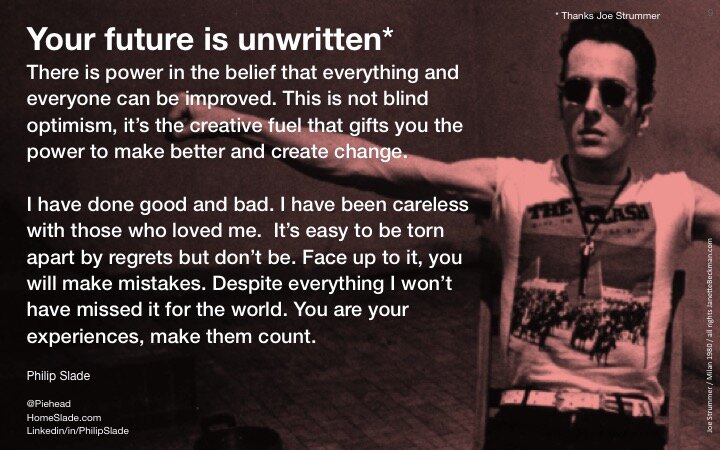If you walk down the street or use social media, you'll see a lot of AI-generated ads. DALL-E 2 and Midjourney allow for creating volumes of polished marketing visuals that kind of look the same. Way too many brands are eagerly lapping up these cookie-cutter AI aesthetics to plug budget holes in their campaigns.
Composition VII, Wassily Kandinsky, 1913, for its time completely non-linear, unconventional thinking
Some have started sounding the alarm about this developing trend. Artist and photographer Sougwen Chung recently said, "I encourage you to continue making works that only a human could make. The world needs your anomalous spirit." She believes that human artists should lead innovation instead of relying on AI tools to produce unoriginal content.
The issue was a big deal at the 2023 Sundance Film Festival. People debated whether using AI-generated art in marketing was okay. Festival founder Robert Redford commented, "When I see these perfect machine-made pictures, I think something's missing...the wonderful imperfections of humankind."
But in this stampede towards AI-generated advertising, we are losing something profound - the human spark. Those gloriously weird, illogical, and downright inexplicable flourishes that set human creativity apart. AI infiltration can homogenise advertising into an army of the bland. I passionately believe we must fight to keep human idiosyncrasies alive.
Logical machines fundamentally lack the ability to think dyslexically. AI is constrained by rules, datasets, and cold calculus. In other words, it is neither friend nor foe, it’s just maths. It cannot escape the bounds of its training or imagine concepts outside its programming. But human cognition has no limits. We make illogical leaps, forge new neural pathways, and see things no algorithm would conceive.
As Einstein said, “Creativity is seeing what others see and thinking what no one else has ever thought.” Human creativity defies rational explanation. It is untamable.
Unfortunately, many current AI creative tools reward conforming to the norm, not breaking free. They analyze thousands of images to detect persisting styles and themes. Output originality is actively discouraged. What you get is a pastiche of familiar elements, remixed ad infinitum. Homogenization prevails.
But look at artists like David Shrigley. His crude, satirical drawings are childlike and warped. Or Matisse’s surreal dreamscapes. Or Frida Kahlo violating anatomy to evoke emotion. Their art arises from nonlinear thinking that no AI can replicate. We need this spirit of human eccentricity and imagination to permeate advertising.
So how do we inject that irrational spark back into brand marketing? First, by valuing dyslexic perspectives in creative teams. The most innovative ideas come from neurodiverse minds who see the world differently. Individuals with dyslexia often possess greater creativity and lateral thinking skills. They should be empowered to follow their unconventional instincts from an early age. Not excluded because of a lack of mathematical prowess.
Human artists collaborate, and then AI can be used sparingly to enhance their vision. Technology should enhance human creativity, not replace it. Without a guiding hand, AI easily descends into repetitive tropes based on what came before. But human imagination gets bored with similarities and seeks the new.
This is why we should always focus ad concepts on storytelling that surprises. Machines struggle to convey innovatively intriguing narratives or make viewers feel joy, sadness, and tension without resorting to what has gone before. While AI is great for cranking out visuals, humans have a monopoly on resonant messaging. Stories speak to our souls.
Popular culture, rejecting previous years of perfect image now embraces imperfections. The wabi-sabi (侘寂)aesthetic finds beauty in imperfection. But AI seeks endless technical refinement, stripping away flaws. Rough edges, irregularity, and chaos open creative possibilities. Agencies and Brands should encourage a culture that values being a bit odd, instead of just focusing on making AI content efficiently. As futurist Kai-Fu Lee said, "To make something new, your mindset has to be a little weird." Innovation arises when marketers embrace the counterintuitive and make space for human strangeness, supported by AI.
In advertising, we stand at a precipice today. One way leads to more automation, AI-created content, and less human marketing. But there is another route. One where technology takes a backseat to imaginative human expressions. Where dyslexic thinking reigns. And where brands embrace the counterintuitive, the weird, and the downright bonkers.
The choice is clear. Do we want advertising ruled by cold, conformist AI algorithms? Or energized by the electric human spark? The irrational human spirit that brought us Picasso’s Cubism, Banksy shredding his own art and the musical idiosyncrasies of Little Simz- creative leaps no machine could conceive.
Dali said it best: “The only difference between myself and a madman is that I am not mad.” In advertising, we really do need more Madmen. (But this time, maybe skip the three martini lunches) We need the mad who are unafraid to be eccentric, make illogical connections, and revel in cognitive dissonance. As AI proliferates, we need the most creative human minds to the fore. The neurodiverse, oddballs need to be supercharged with the aid of AI. Brilliance will arise in the unpredictable spaces and tensions between man and machine.
So in this age of artificial intelligence, let us champion radical human creativity. Embrace what makes our cognition untamable. And fill advertising with the electric, inexplicable human spark. Yes amplified by AI, but steered by humans from start to finish.
























